Photo / Video News & Reviews
A Guide to Underwater Wildlife Video & Editing: Part 1
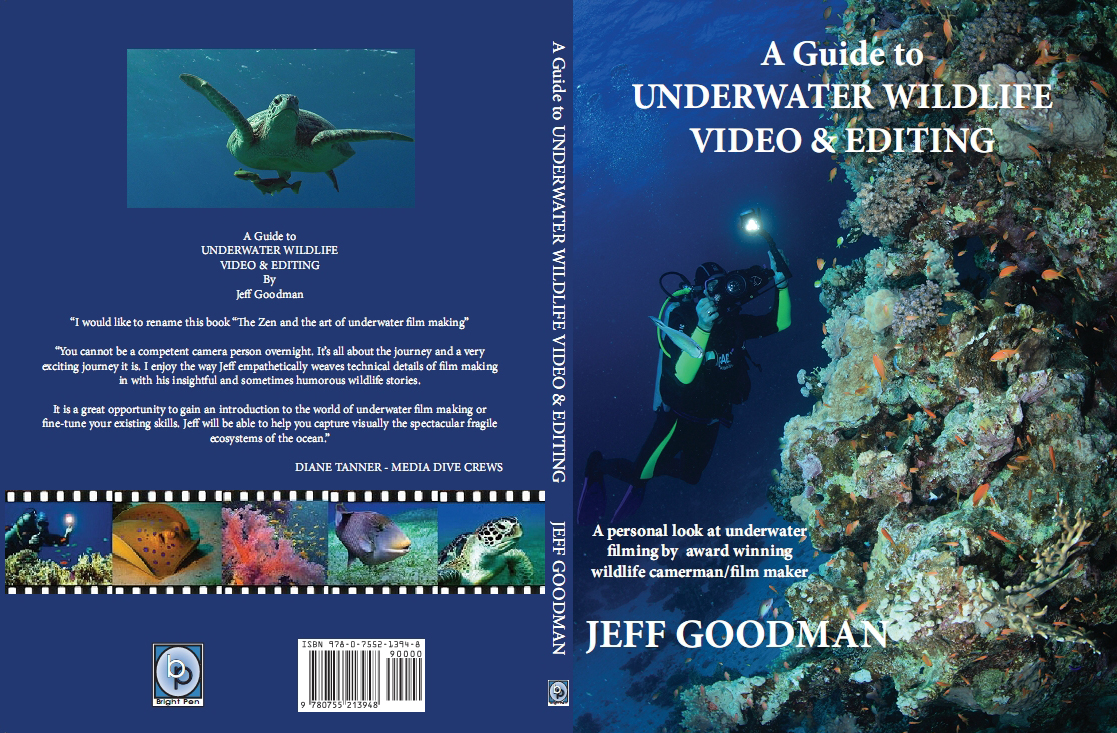
A part serialisation of a book by Jeff Goodman
Profile: Born in Devon, England, Jeff now lives in Cornwall where the horizons are clear and bright. He has been a freelance television underwater and wildlife cameraman from the age of 22, filming mostly for BBC, Discovery and National Geographic. With this book, Jeff takes the reader through all the basics of film-making and editing underwater wildlife video. How to choose a camera and underwater housing, finding and filming the subject, right through to the editing process on your home computer. Jeff enables the production of a quality video presentation with music and narration.
Throughout this serialisation of the book, Jeff shares some of his more poignant experiences from filming on location. His stories explore our relationships with the natural world and our place within it. His love of the oceans is evident throughout and so encourages any reader to look at the marine environment as a unique and magnificent ecosystem.
We will be looking at cameras, how to choose and how to use them. Lighting, editing and many other aspects of getting the very best video images and sequences will follow.
Forward by BBC TV Wildlife & Underwater Presenter Miranda Krestovnikoff
“A Guide to Underwater Filming and Editing” is a technical manual with a truly light touch. It enables us to begin to film marine animals, plants and habitats with confidence and care. The layout is based on the filming courses that Jeff runs, and is tried, tested and proven successful. The technical aspects are easily mastered by anyone, the compositional elements make a sound base from which to develop one’s own style, and the straightforward text guides the filmmaker right through to their premiere!”
PART 1: Introduction
Things have certainly changed since I began my career as a wildlife cameraman. Technology in all its facets has brought the capability of making good wildlife videos, especially underwater, within reach of most people. When I started, in the late seventies, professional and semi professional movie cameras were a very specialised item, particularly with any sort of underwater housing. Now, the modern day high street store or web shop can supply a whole variety of cameras and housings pretty well tailored to fit requirements and budget.
Technology has also made the process of shooting video easy. ‘Point & Shoot’ cameras are very good and the quality can be excellent. A bit further up the scale we have cameras that give us the option of either using complete ‘auto’ or complete ‘manual’ with a few combinations in between.
So, why learn about equipment and how to make underwater films when technology has so many things placed in the ‘auto’ folder of life? Basically ‘auto’ will only take you so far and while producing a very immediate image; it will not replace your mind as a thinking decision maker, with a sense of artistic ability. While many people are, quite rightly, excited about the first video clips they make, there soon comes a time when the desire to do better things arises.
Whether you are intending to make a professional broadcast film or a good quality hobby video, the basic principles of making that film are the same. A cameraman must know the camera and its underwater housing controls fully and be able to use all its required functions without any second thought. Imagine the scenario of getting to a location – saving the money, deciding where to go, getting the tickets, passports, currency, excess baggage, travel to airport etc etc. You get the picture. Finally you get to the location you have dreamed about. Now you organise the diving – where to go, what state of tide, what time of day, how deep, who to go with, etc etc. Finally after all this preparation and anticipation you are in the water and the conditions are good. Without any warning, there in front of you, is the animal you came to film and incredibly, it’s doing its thing! You are excited, you lift the camera up to shoot and then panic as you ask yourself – is it in focus, is the exposure right, what about colour balance and so on ??? – and then in that brief moment while you are deliberating over the camera settings, the animal swims away, or buries itself in the sand, or simply stops what it is doing to look at what you are doing. Oh! the sheer frustration of not being prepared! ‘I should have used auto,’ you may think to yourself, and perhaps you should have, but knowing where and when not to use ‘auto’, is part of the whole deal.
But let’s suppose you get some great shots, the next question is what are you going to do with them? Show your fellow divers – show the family (and let’s face it, they will love anything thing you do) – then what? If that’s all you want to do then probably the ‘auto’ way of life is not such a bad thing, but, if you want a little more out of all your hard work, then perhaps this book is for you.
Most people with a modern video camera get to take some excellent shots now and again, but it takes a little more effort and thinking to be able to produce a video sequence that will enthral your audience and keep them entertained until the very last frame has been seen. This applies to the absolute beginner right up to the semi – professional. By the time you may become a professional, all these skills will be second nature, allowing more time to think about animal behaviour and to predict what is about to happen next. This is where research and knowledge of the species you are filming becomes invaluable and knowing what is going on, and perhaps what to wait for, instead of just shooting away only to achieve a simple catalogue of animal portraits instead of a good behavioural sequence.
So, being a good cameraman does not end with just knowing your camera and being skilful in getting all the best shots. As any video editor will tell you, every shot can be a masterpiece, but if there is not enough variety of material to make a full sequence, then all that effort can be wasted. A great shot is of course a great shot and this is most obvious when taking a still photograph. But with video, the story doesn’t end there. All the time you are filming you have to be thinking about your final video product. ‘I have a great shot, but how am I going to get into it story-wise and then how am I going to get out of it and into the next great shot?’…….and so on. Editing is a crucial part of film making and in my opinion no professional cameraman is truly worth his or her salt until they have spent some time in an edit room and seen how sequences are made and fitted together.
It is with equal attention that this book will look at cameras, how to get the best from them, how to approach filming your subjects and how to ensure you have enough material to make a good and full sequence. We will then look in detail at how to put your hard earned shots together with easy to use consumer editing software.
There are many skills and qualities that make a good wildlife underwater camera person. A few of these are confidence in their diving abilities, slow and easy going in movement while approaching marine life, a good degree of knowledge about the subject, being able to give the correct body posture and not to appear threatening. When filming wildlife there are often no second chances and so we discuss later a ‘whole new way of diving’.
The next part of this serialisation will look at how to choose a camera and housing.
Blogs
Diver Discovering Whale Skeletons Beneath Ice Judged World’s Best Underwater Photograph
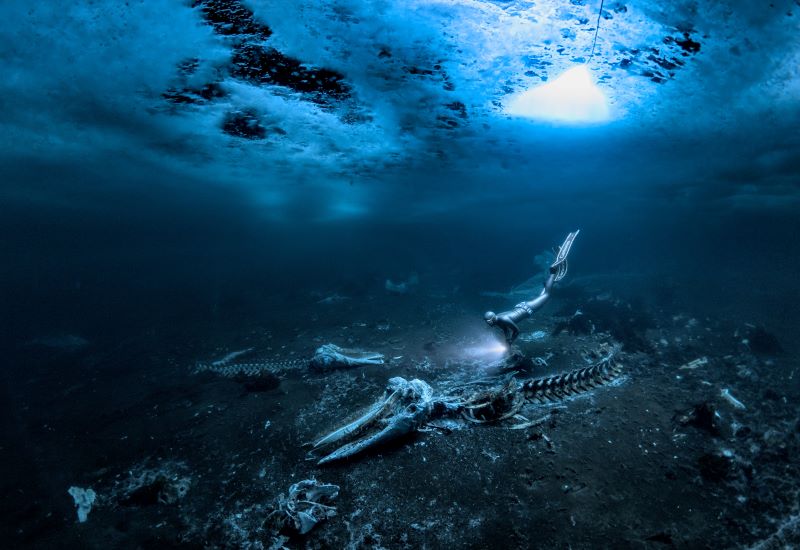
An emotive photograph showing a freediver examining the aftermath of whaling sees
Alex Dawson from Sweden named Underwater Photographer of the Year 2024. Dawson’s
photograph ‘Whale Bones’ triumphed over 6500 underwater pictures entered by underwater
photographers from around the world.
“Whale Bones was photographed in the toughest conditions,” explains chair of judging
panel Alex Mustard, “as a breath-hold diver descends below the Greenland ice sheet to bear
witness to the carcasses. The composition invites us to consider our impact on the great
creatures of this planet. Since the rise of humans, wild animals have declined by 85%. Today,
just 4% of mammals are wildlife, the remaining 96% are humans and our livestock. Our way
needs to change to find a balance with nature.”
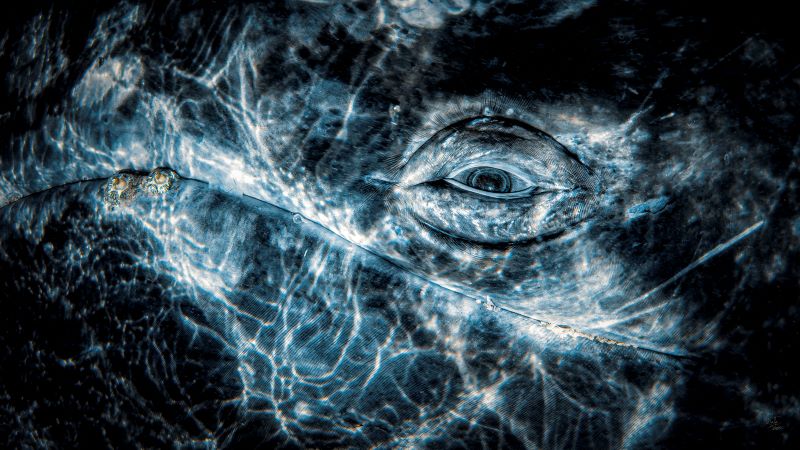
Photo: Rafael
Fernandez Caballero
Whales dominated the winning pictures this year with Spanish photographer Rafael
Fernandez Caballero winning two categories with his revealing photos of these ocean giants:
a close up of a grey whale’s eye and an action shot of a Bryde’s whale engulfing an entire bait
ball, both taken in Magdalena Bay, Baja California, Mexico. Fernandez Caballero took ‘Grey
Whale Connection’ while drifting in a small boat, holding his camera over the side in the water
to photograph the curious whale. ‘The End Of A Baitball’ required Fernandez Caballero to dive
down and be in exactly the right place at the moment the whale lunged. “The photo shows
the high speed attack,” he said, “with the whale engulfing hundreds of kilograms of sardines
in one bite — simply unforgettable to see predation on such a scale.”
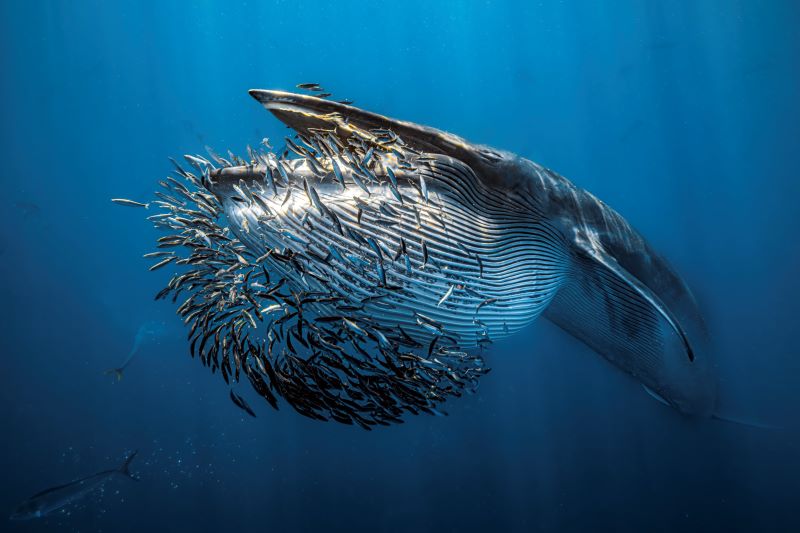
Photo: Rafael
Fernandez Caballero
Lisa Stengel from the United States was named Up & Coming Underwater Photographer of the Year 2024 for her image of a mahi-mahi catching a sardine, in Mexico. Stengel used both a very fast shutter speed and her hearing to catch the moment. “If you listen there’s an enormous amount of sound in the ocean,” she explained. “The action was too fast to see, so I honed in on the sound of the attacks with my camera to capture this special moment.”
“It is such an exciting time in underwater photography because photographers are capturing such amazing new images, by visiting new locations and using the latest cameras,”
commented judge Alex Mustard. “Until this year I’d hardly ever see a photo of a mahi mahi,
now Lisa has photographed one hunting, action that plays out in the blink of an eye.”
The Underwater Photographer of the Year contest is based in the UK, and Jenny Stock,
was named as British Underwater Photographer of the Year 2024 for her image “Star
Attraction”, which finds beauty in species of British wildlife that are often overlooked.
Exploring the west coast of Scotland, Stock explained “in the dark green depths my torch
picked out the vivid colours of a living carpet of thousands of brittle stars, each with a
different pattern. I was happily snapping away, when I spotted this purple sea urchin and I
got really excited.”
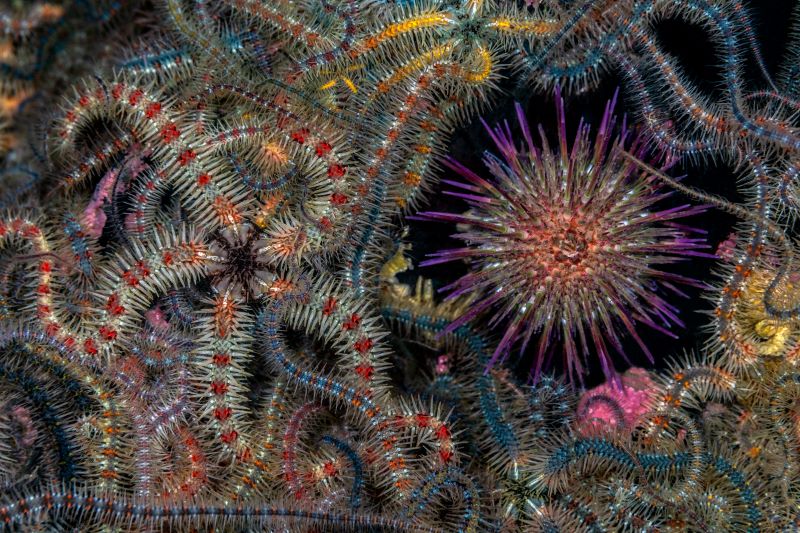
Photo: Jenny Stock
In the same contest, Portuguese photographer, Nuno Sá, was named ‘Save Our Seas
Foundation’ Marine Conservation Photographer of the Year 2024, with his photo ‘Saving
Goliath’, taken in Portugal. Sá’s photo shows beachgoers trying to save a stranded sperm
whale. The picture gives us hope that people do care and want to help the oceans, but also
warns us that bigger changes are needed. “The whale had been struck by a ship and its fate
was sealed,” explains Sá. “An estimated 20,000 whales are killed every year, and many more
injured, after being struck by ships-and few people even realise that it happens.”
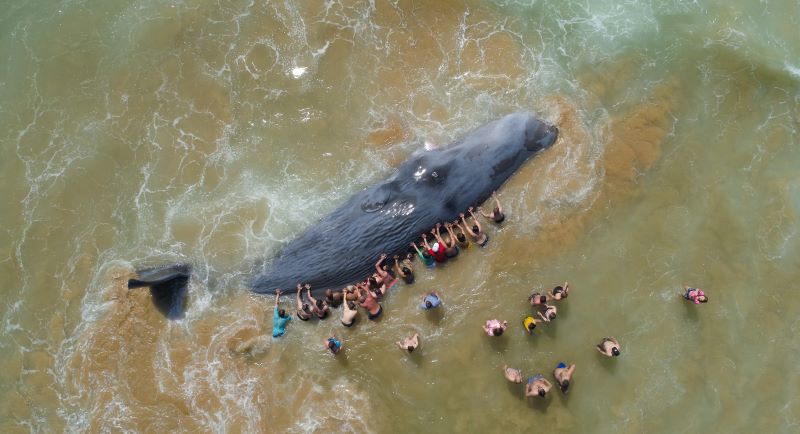
Photo: Nuno Sá
More winning images can be found at www.underwaterphotographeroftheyear.com.
About Underwater Photographer of the Year
Underwater Photographer of the Year is an annual competition, based in the UK, that celebrates photography beneath the surface of the ocean, lakes, rivers and even swimming pools, and attracts entries from all around the world. The contest has 13 categories, testing photographers with themes such as Macro, Wide Angle, Behaviour and Wreck photography, as well as four categories for photos taken specifically in British waters. The winners were announced in an award ceremony in Mayfair, London, hosted by The Crown Estate. This year’s UPY judges were experienced underwater photographers Peter Rowlands, Tobias Friedrich and Dr Alexander Mustard MBE.
Header image: Underwater Photographer of the Year 2024 winner Alex Dawson
News
World’s Best Underwater Photographers Unveil Breathtaking Images at World Shootout 2023
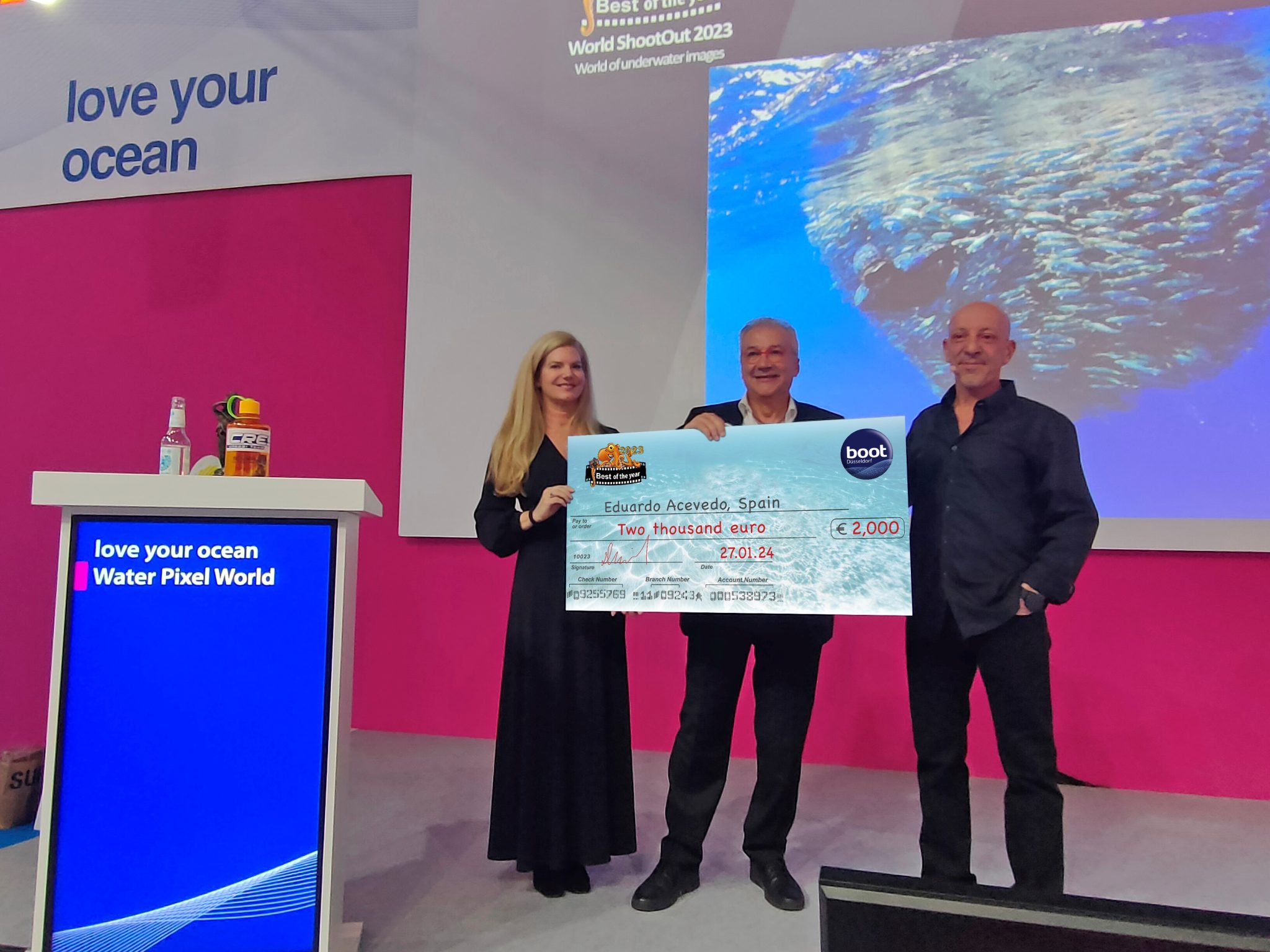
The winners of the prestigious World Shootout 2023 underwater photography competition were announced at this year’s BOOT Show, captivating audiences at the world’s largest diving and water sports exhibition in Dusseldorf, Germany. Hundreds of photographers from 54 countries competed across nine categories, pushing the boundaries of creativity and technical skill.
Grand Prize Winners
- Picture of the Year: Spanish photographer Eduardo Acevedo “secured” the top Honor with the prestigious prize the “boot Dusseldorf Director’s Prize, earning an Andromeda statuette and a €2,000 cash prize.
- Best 5 Images Portfolio: Luc Rooman from Belgium triumphed in this category, winning a dream 4-week diving trip for two to Papua New Guinea, valued at $18,900.
- Amateur Photographer: Alexandra Ceurvorst from the USA impressed the judges with her talent, taking home the 1,000 € cash prize award.
Celebrating Diversity and Innovation
This year’s competition saw 11,680 entries from 964 photographers, showcasing a remarkable spectrum of skills and perspectives. From the intricate wonders of Macro photography to the beauty of “Black Water”, the “Underwater Fashion” category added a touch of artistry and innovation, while the ever-important ” Environmental & Conservation” category served as a powerful reminder of the need to protect these fragile ecosystems.
Looking Ahead: AI and Ocean Conservation
World Shootout founder and producer David Pilosof unveiled an exciting addition for the 2024 competition: this year the Environmental category will be focusing on the impact of plastic on our oceans and future.
This category will embrace the potential of AI or other editing software as a tool to amplify the conservation message.
Entrants will submit campaigns of three original underwater photographs dealing with plastic pollution, along with their final AI assistance processing. This innovative approach encourages artistic expression while raising awareness about a critical environmental issue.
Explore the Stunning Collection
Discover the complete album of competition entries by clicking here.
For Low-resolution photos of finalist entries in eight categories, click here.
-

 News3 months ago
News3 months agoHone your underwater photography skills with Alphamarine Photography at Red Sea Diving Safari in March
-

 News3 months ago
News3 months agoCapturing Critters in Lembeh Underwater Photography Workshop 2024: Event Roundup
-

 Marine Life & Conservation Blogs2 months ago
Marine Life & Conservation Blogs2 months agoCreature Feature: Swell Sharks
-

 Blogs2 months ago
Blogs2 months agoMurex Resorts: Passport to Paradise!
-

 Blogs2 months ago
Blogs2 months agoDiver Discovering Whale Skeletons Beneath Ice Judged World’s Best Underwater Photograph
-

 Gear Reviews3 months ago
Gear Reviews3 months agoGear Review: Oceanic+ Dive Housing for iPhone
-

 Marine Life & Conservation2 months ago
Marine Life & Conservation2 months agoSave the Manatee Club launches brand new webcams at Silver Springs State Park, Florida
-

 News3 months ago
News3 months agoWorld’s Best Underwater Photographers Unveil Breathtaking Images at World Shootout 2023
















